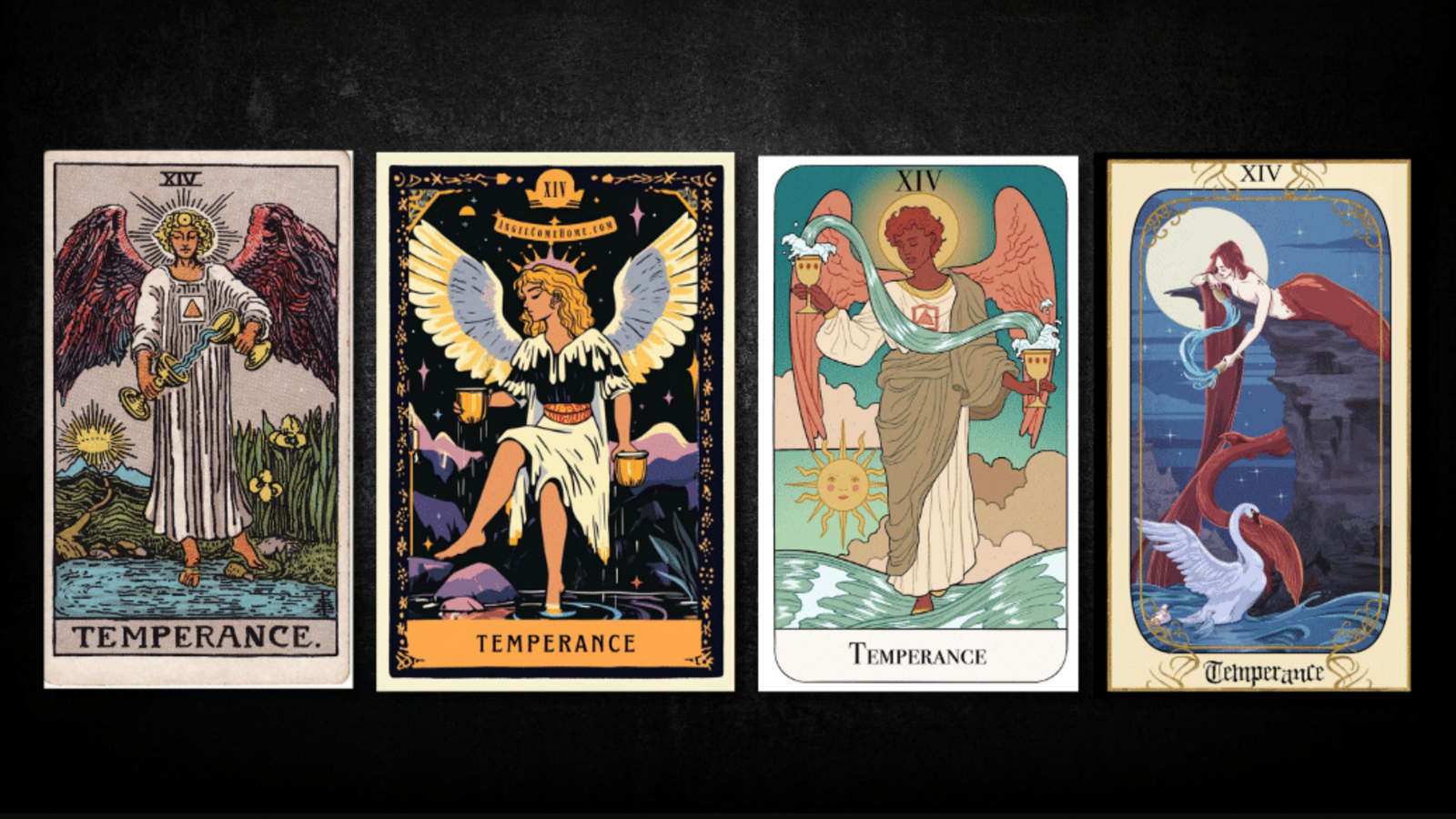Tarot Deep Dive: The Meaning Behind Temperance with Total Apex Media

You know that moment when you finally stop swinging between “all in” and “burn it down”? When you breathe, step back, and realize you don’t have to choose chaos or control — you can find your own rhythm somewhere in between? That’s Temperance. Card XIV in the Major Arcana, and probably one of the most slept-on, underestimated cards in the whole deck. Temperance shows up when you’re learning how to blend — your past and present, your head and heart, your power and your patience. It’s not about shutting down your fire. It’s about learning how to carry it without getting scorched. Symbolism and Meaning of Temperance At first glance, Temperance seems… chill. There’s an angel, wings out, standing still, slowly pouring water between two cups. Nothing intense, nothing chaotic. But under that stillness? There’s something deeper happening — a quiet kind of transformation. The details matter. Like: One foot on land, one in water — This is the card’s way of saying, “You’ve gotta stay grounded, but you can’t shut off your feelings.” It’s balance — not just emotionally, but in every sense. Head and heart. Logic and instinct. Living in the real world, but staying grounded. Pouring water from one cup to another — It’s not flashy, but it’s powerful. This is the part where you take everything you’ve learned and start weaving it together. Not throwing parts of yourself out — blending them into something that actually works. That little path in the background leading to the sun — You’re not just stuck in the middle. This peace has a direction. You’re on your way somewhere, even if it’s slow. The triangle inside the square on their chest — Honestly? It’s easy to overthink symbols like this, but it’s a reminder that your soul — your truth — can live inside structure. You don’t have to choose between being spiritual and being a functioning human. You can be both. When Temperance is upright, it usually means you’re finding your footing. You’re learning how to live in the middle space — not clinging to the past, not rushing the future. You’re figuring out what fits now, what still matters, and how to move with more intention. If it’s reversed, you might feel like you’re trying too hard to force balance — or maybe you’ve given up on it altogether and swung into old patterns. Either way, the message is the same: slow down. Don’t run. Don’t hide. Just breathe, and see what needs adjusting. Temperance isn’t here to judge you. It’s here to help you stop swinging so hard and start finding your rhythm again. Temperance in Readings Temperance in reading is like a deep breath after a storm. It says: you don’t need to rush. You’re already in motion — the key now is to stay steady and clear. This card tends to show up: After a major life shake-up (hello, Tower fallout) When you’re figuring out how to heal, not just “move on” When you’re learning how to balance parts of yourself that used to feel at war It’s the spiritual version of a tuning fork — helping you find your frequency again. Love and Relationships Temperance in love is all about balance — not “perfect harmony,” but the kind that’s earned through honesty, patience, and actually showing up for each other. If you’re in a relationship: This card asks you to meet in the middle. Not compromise to the point of losing yourself, but build something sustainable together. Communicate. Soften. Mix your truths instead of competing with them. If you’re single: It might be time to recalibrate your patterns. Are you chasing emotional highs, or looking for something rooted? Temperance says: start by becoming the partner you’d want to date. Reversed, you might be trying to force something that isn’t flowing — or staying in something too long just because it used to feel balanced. Be real with yourself about what peace actually looks like. Career and Money If Temperance had a motto for your career or finances, it’d probably be: slow down but don’t stop. This card is the antidote to burnout, chaos, and 12-hour days with nothing left to show for it. It’s the reminder that steady progress still counts — and honestly, it lasts longer anyway. Here’s what it might be saying: Is that collaboration or a team project? It only works if everyone’s bringing their strengths and their self-awareness. That pressure you’re feeling to keep pushing harder? It might actually be time to take a step back before you crash. That blend of skills you’ve got? The creativity, the strategy, the big vision — that’s not a mess. That’s your edge. Use it. Reversed Temperance in career readings can mean you’re spread too thin or trying to “balance” everything while secretly neglecting what you actually need. That could be rest. Boundaries. Time away from your inbox. Whatever it is, your center’s asking for attention. Give it some. Personal or Spiritual Growth This is where Temperance really lands hard — and softly, at the same time. Spiritually, this card is about learning to live in your truth without needing to shout it. It’s the quiet confidence of someone who knows who they are and doesn’t need to prove it to anyone. This might be the season where you: Create a ritual that brings your day into focus Finally, make peace with a part of yourself you’ve been trying to fix Stop needing every answer and start trusting the process a little more Reversed, this could show up as spiritual overload — chasing too many practices, trying to force clarity, or using “growth” as a distraction from actually feeling your feelings. Temperance says: you don’t need more. You need integration. Mythology, History, and Cultural References Temperance in tarot has always been about balance, but not in the sterile, virtue-signaling kind of way. Early decks like the 15th-century Visconti-Sforza, showed a woman carefully pouring liquid between two flasks — a quiet image that held a lot of power. Back then, it represented one of the cardinal virtues, the kind that holds society (and the self) together. But the deeper root? Alchemy. In that tradition, tempering meant transforming raw elements into gold — through fire, time, and patience. It’s a long game. The kind that changes you from the inside out. You also see echoes of Temperance in lesser-known myths, like: Ariadne, after Theseus left her — she doesn’t spiral or vanish. She rebuilds and becomes a goddess in her own right. That’s alchemy. Chang’e, the Chinese moon goddess — isolated, grieving, and yet serene, still a source of light and balance in the night sky. Sedna, the Inuit sea goddess — her story is brutal, but she becomes the guardian of life under the sea. Through pain, she finds purpose — and becomes part of a larger balance in nature. And pop culture? Here’s where it gets interesting — because Temperance isn’t usually the lead. But it’s the arc underneath. The quiet growth. The long transformation. Kendall Roy (Succession) — hear me out: beneath the chaos, his story is about learning to hold power differently — not through ego, but eventually through acceptance and clarity. Elliot (Mr. Robot) — shattered parts of himself that eventually integrate into one whole truth. Not clean. Not easy. But real. Beth Harmon (The Queen’s Gambit) — addiction, talent, grief — all eventually woven into a version of herself that’s whole, not perfect. Frankie (Better Things) — learning to be soft and strong, growing up without giving up her weird, beautiful self. Quiet power in progress. Temperance doesn’t make headlines. But it changes lives. Slowly, steadily, and for real. Final Thoughts on Temperance Temperance isn’t here to shake things up. It’s here to help you land. Not with a bang — with clarity. With peace. When this card shows up, it’s not asking you to be perfect, fully healed, or totally chill all the time. It’s just asking you to stop flipping between extremes and come back to what’s real right now. Not what you “should” feel. Not what’s ideal. Just what’s honest. This isn’t about playing small — it’s about getting clear. Temperance is that quiet voice inside that says, “You don’t have to rush. Just be here. Blend what’s working. Let go of what’s not. And trust that you don’t have to pick a side between chaos or control.” So pour slowly. Check your mix. Keep adjusting. That’s where the magic is — not in perfection, but in the practice.









![In 1972, the Soviet Union launched the Kosmos 482 probe to visit Venus. 53 years later, it's finally coming home [Interesting]](https://usrimg-full.fark.net/N/NJ/fark_NJrd_k-mYBHFE5PqSIUa6IwZuBw.jpg?AWSAccessKeyId=JO3ELGV4BGLFW7Y3EZXN&Expires=1746417600&Signature=tC6kHOl0j0aYQhJG1w%2F7UvxreW4%3D)








